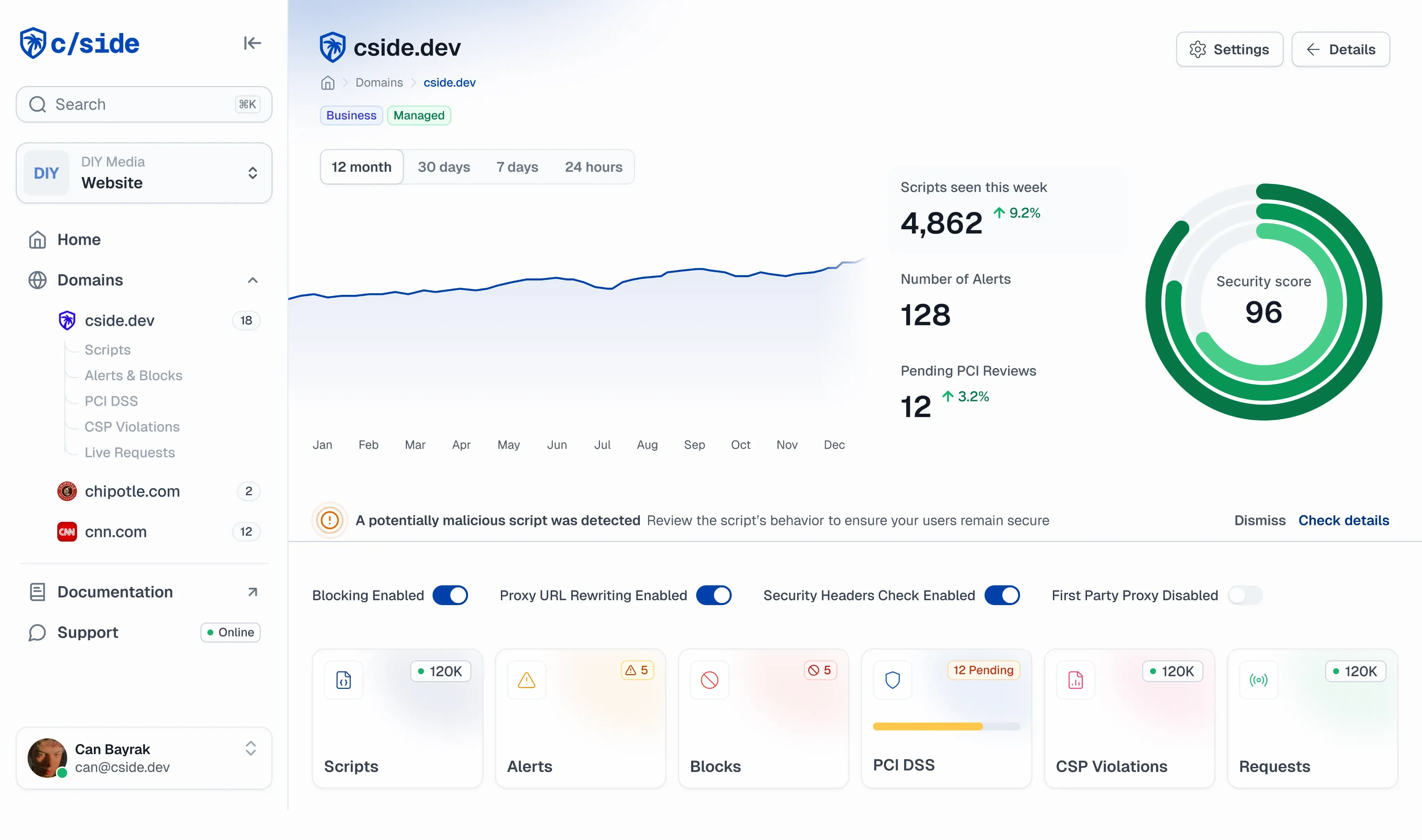How to comply with PCI DSS 4.0.1 - 6.4.3 and 11.6.1
cside allows you to manage and comply with both requirements.

cside allows you to manage and comply with both requirements.

The Payment Card Industry Data Security Standard (PCI DSS) is a set of guidelines that ensures the safety of card transactions globally. Created by the PCI Security Standards Council, its goal is to protect against data theft and fraud in debit and credit card transactions.
PCI DSS 4.0.1 applies to all entities that store, process, or transmit cardholder data (CHD) and/or sensitive authentication data (SAD), or could impact the security of the cardholder data environment (CDE). This includes all payment card account processing entities such as merchants, processors, acquirers, issuers, and other service providers. A new addition to 4.0.1 is the monitoring and management of 3rd-party JavaScript, tackled by requirements 6.4.3 and 11.6.1.
On January 30th 2025, the PCI DSS announced an update to requirements 6.4.3 and 11.6.1. Self Assessment Questionnaire level A companies are exempt, although they must confirm their site is not susceptible to attacks from scripts that could affect the merchant's eCommerce system(s).
SAQ A, designed for the least vulnerable merchants, exempts them from certain PCI DSS requirements given they do not store Card Holder Data (CHD). However, comprehensive monitoring remains critical for security.
cside automates both requirements 6.4.3 and 11.6.1 with real-time script monitoring, integrity verification, and comprehensive audit-ready reporting.
As part of the PCI DSS 4.0.1 additions that became mandatory on March 31 2025, requirement 6.4.3 demands companies:
On pages that handle sensitive user information (payment cards, health information, PII) you need to have a mechanism in place to monitor 3rd party scripts, what they are doing to your user's browsers, and alert security teams when scripts are behaving suspiciously.
Mandatory since March 31, 2025 for any website that takes digital payments
As part of the PCI DSS 4.0.1 additions that became mandatory on March 31 2025, requirement 11.6.1 demands companies:
HTTP headers are rules that tell a user's browser how to handle content on a page. Altering those headers (e.g. by a malicious script) can weaken security protections. PCI DSS 11.6.1 requires businesses to have a mechanism that regularly checks (at least once every seven days) for unauthorized header changes and alerts the security team when they occur.
Requires technical monitoring and evaluation capabilities
*Definitions based on PCI DSS v4.0.1 - Jun. 2024. This is the most up to date version as of September 2025. To view official documents visit the PCI SSC library .
Many traditional solutions only aim to check the compliance box, not deliver the highest level of security. Crawler-based approaches scan periodically and can be evaded. CSPs address source, not payload. Client-side agents can be detected and bypassed.
cside uses a proxy solution sitting between 3rd party scripts and the browser. We see every script request and payload, providing real-time alerts and blocking capabilities before users are compromised.
Complete visibility into script behavior, historical tracking, and the ability to detect dynamic or user-specific threats that other solutions miss.
| Criteria | Why it Matters | What the Consequences Are | CSP | Crawler | JS-Based | Hybrid |
|---|---|---|---|---|---|---|
| Real-time Protection | Attacks can occur between scans or in the excluded data when sampled | Delayed detection = active data breaches | | | | |
| Full Payload Analysis | Ensures deep visibility into malicious behaviors within script code itself | Threats go unnoticed unless the source is known on a threat feed | | | | |
| Dynamic Threat Detection | Needed for incident response, auditing, and compliance | Avoids trade-offs between performance and security | | | | |
| 100% Historical Tracking & Forensics | Needed for incident response, auditing, and compliance | Avoids trade-offs between performance and security | | | | |
| No Performance Impact | Avoids trade-offs between performance and security | Higher page load times can reduce conversions and hurt UX | | | | |
| Bypass Protection | Stops attackers from circumventing controls via DOM obfuscation or evasion | Stealthy threats continue undetected | | | | |
| Certainty the Script Seen by User is Monitored | Aligns analysis with what actually executes in the browser | Gaps between what's reviewed and what's actually executed | | | | |
| AI-driven Script Analysis | Detects novel or evolving threats through behavior modeling | Reliance on manual updates, threat feeds or rules = slow and error-prone detection | | | | |
| Implementation Complexity & Timeline | Impacts time-to-value and internal resource costs | Long deployment timelines reduce agility | High | Medium | Medium | Low |
| Can meet 11.6.1 requirement | 11.6.1 relates to monitoring changes in the security headers as well as the script contents themself | Not monitoring security headers violates 11.6.1—missing or altered headers signal potential attacks | | | | |
Leading companies trust cside


















Built for security teams who need visibility inside the browser, cside delivers proven defense against modern client-side attacks while supporting major compliance frameworks. Your trusted partner for regulatory compliance in the browser.
Visit our Trust Center GDPR
GDPR  SOC 2
SOC 2  PCI DSS
PCI DSS Start monitoring and securing 3rd party scripts on your websites today. Comply with PCI DSS 4.0.1 requirements 6.4.3 and 11.6.1.
*This page describes product capabilities and how they may support your compliance program. It is not legal advice. Requirements vary by organization and jurisdiction.